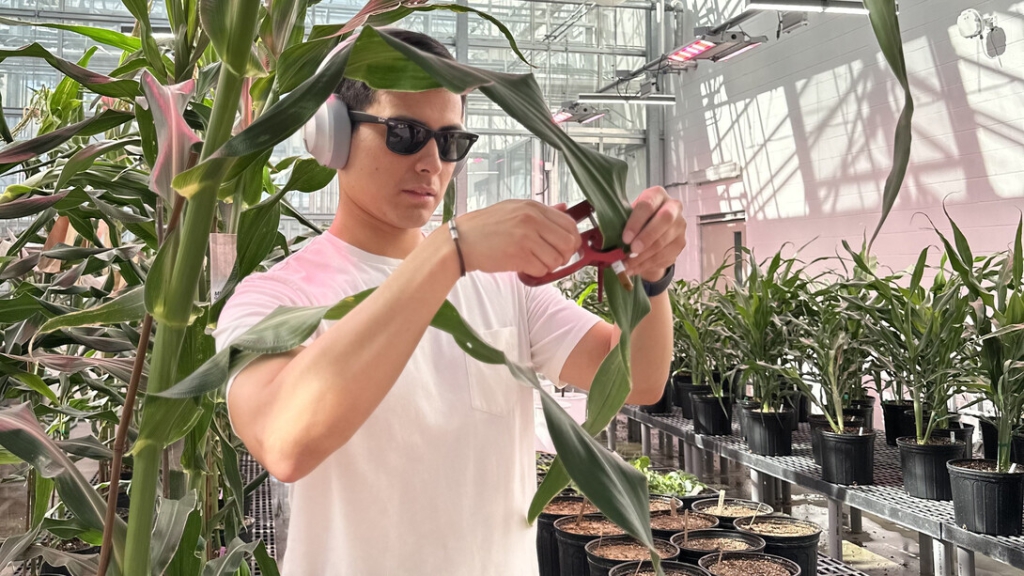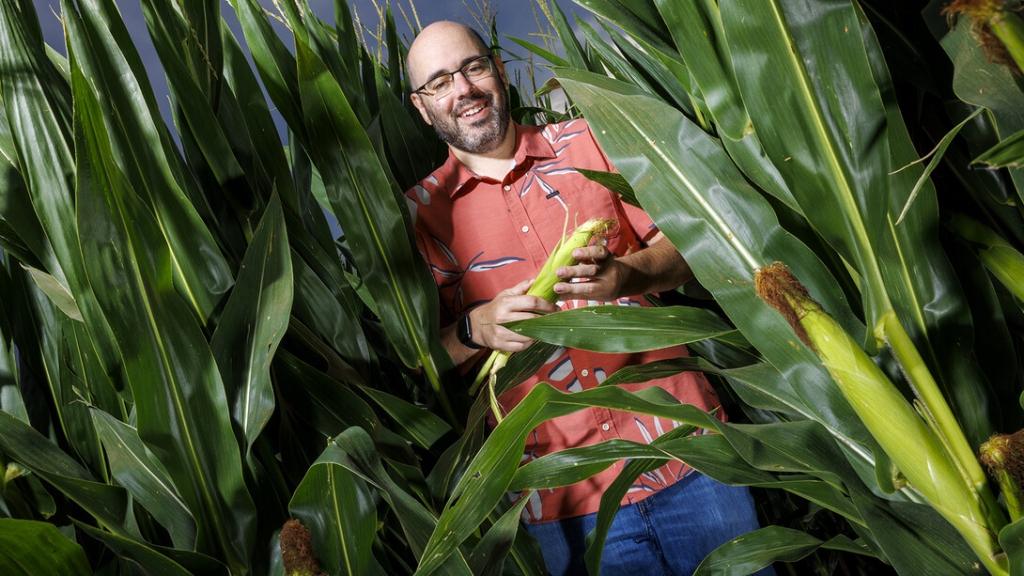Tiffany Lee, August 5, 2024
Schnable expands work to ID corn genes, predict hybrid performance
A University of Nebraska–Lincoln research team has received funding from the U.S. Department of Energy to advance work on an innovative strategy for predicting the performance of corn hybrids in new environments.
The work is an important step toward commercializing new crop varieties that produce better results than today’s standard.
Plant scientist James Schnable received a $650,000 grant from the DOE’s Advanced Research Projects Agency-Energy to scale up a study his laboratory published earlier this summer. The research provided initial evidence that an RNA-based method could outperform current approaches that use DNA-based information to identify the functions of individual corn genes and predict the physical properties of the plants.
With the new funding, Schnable’s team will see if those original results, derived from experiments in Nebraska and Michigan, hold up when their method is applied to data from up-to-date hybrid varieties grown nationwide. The team will partner with collaborators in Nebraska and five other states to collect RNA data, fine-tune a predictive model, and compare that model’s results against those produced by some of the world’s best DNA-based techniques.
This next phase — the largest study to date focused on an RNA-based approach to corn gene identification and phenotype prediction — is crucial for transforming the team’s scientific breakthrough into a commercially viable product that will benefit farmers in Nebraska and beyond.
“By being able to test across many environments with really farmer-relevant genetics, we want to make the transition from a fundamental discovery to a technology that people can actually use,” said Schnable, Nebraska Corn Checkoff Presidential Chair and professor of agronomy and horticulture.
The work could help meet demand for increasing the productivity and efficiency of corn at a time when a rapidly changing environment — from longer growing seasons to variable rainfall patterns to new regulations focused on nitrogen pricing and herbicides — is complicating efforts to forecast which new hybrids will be the best ones to commercialize in the future.
“We have a real challenge in corn breeding in that it still takes seven to 10 years to develop a new hybrid, from doing initial tests in the field to putting a variety in farmers’ hands,” Schnable said. “If we can develop better methods to predict which hybrids will perform in new environments before we’ve tested them, we can both shorten that cycle and do a better job of developing and releasing hybrids that are going to be high yielding and resilient in the environment of Nebraska in 2030 or 2035, instead of asking future farmers to make do with hybrids designed for the Nebraska of 2020 or 2024.”

In the now-completed first phase of the project, Schnable and Vladimir Torres-Rodríguez overcame a longstanding barrier to using an RNA-based technique for gene identification: Because RNA values fluctuate throughout the day, scientists had long considered it nearly impossible to collect data from hundreds of corn plants fast enough to ensure the RNA from each plant would be consistent with the others. Jonathan Turkus, a research manager in the Center for Plant Science Innovation, helped the research team clear that hurdle.
Using equipment at Nebraska Innovation Studio, the makerspace at Nebraska Innovation Campus, Turkus fabricated tools that allowed the team to collect more than 2,500 samples from nearly 700 varieties of corn and immediately flash freeze them, all in a span of about two hours. The work resulted in the world’s largest dataset of RNA levels in different plants measured in a single experiment. The new sampling instruments Turkus designed and built were a major key in unlocking the potential of RNA in gene function analysis, Schnable said.
Torres-Rodríguez, a postdoctoral associate in Schnable’s lab, led the way in developing a statistical framework to link the RNA values to gene function. Then, in collaboration with private sector partners, they used machine learning and artificial intelligence techniques to develop a model that uses RNA data to predict plant properties.
The results were exciting as the RNA-based model was able to identify about 10 times as many corn genes that helped determine when corn plants would flower than widely used DNA-based methods. But the study was not large enough to attract funding from private companies that wanted to see the model’s durability across a range of environments, as well as how effectively it can predict grain yield and other farmer-relevant traits in corn hybrids more closely related to those growing today.
With the new funding, the team will address both issues. For this round, the team will use corn hybrids that recently came off patent, which are the closest to what Nebraska farmers are using today that the scientists can access for unrestricted research purposes.
The team is also partnering with members of the Genomes to Fields Initiative to collect RNA data from a geographically diverse range of states including Nebraska, Michigan, Missouri, North Carolina, South Carolina and Georgia.
They will use that data to further train their RNA-based prediction models — then test to see how the results hold up against DNA-based models run by some of the world’s foremost experts in plant phenotype prediction as part of the Genomes to Fields yield prediction contest. In that competition, researchers from the public and private sectors around the globe compete to produce the best possible prediction results.
If the RNA-based model outperforms the traditional approaches, it will be a major step toward bringing the tool to the private sector and into the hands of plant breeders and farmers. The project is an opportunity for Nebraska researchers to showcase their work’s potential to make real-world impacts.
“One of the really compelling things for me about this award is that it is an example of a federal agency putting money into Nebraska not only to do new fundamental research, but to make that translational step from the fundamental breakthrough to commercialization and economic impact,” Schnable said.






